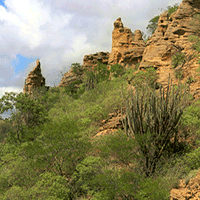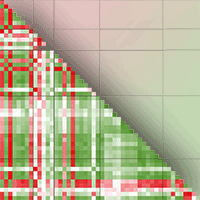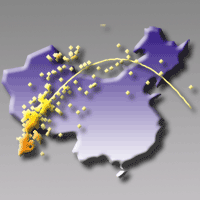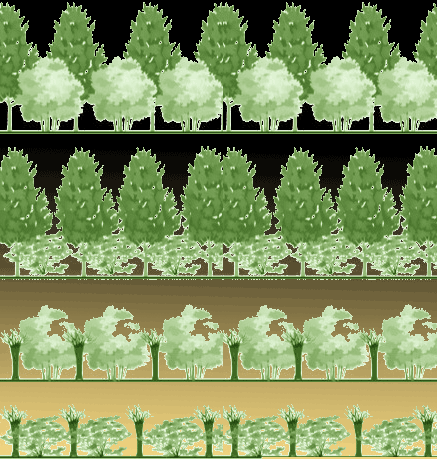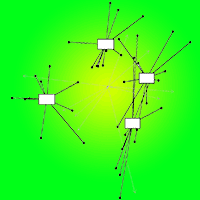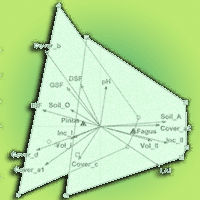
Effects of planted European beech on the understory in Scots pine forests of Lithuania
Vitas Marozas (1) , Algirdas Augustaitis (1), Kestutis Armolaitis (2), Almantas Kliucius (1), Mantas Pilkauskas (1)
iForest - Biogeosciences and Forestry, Volume 7, Issue 1, Pages 12-18 (2014)
doi: https://doi.org/10.3832/ifor0695-007
Published: Oct 07, 2013 - Copyright © 2014 SISEF
Research Articles
Collection/Special Issue: IUFRO 7.01.00 - COST Action FP0903, Kaunas (Lithuania - 2012)
Biological Reactions of Forest to Climate Change and Air Pollution
Guest Editors: Elena Paoletti, Andrzej Bytnerowicz, Algirdas Augustaitis
Abstract
Understanding how the planting of non-native species impacts native vegetation is of most importance for forest management, as introduced species may alter environmental conditions with respect to soil composition, light intensity, and species composition. Here, we compared the stand structure, understory vegetation and site properties of a natural Scots pine (Pinus sylvestris L.) stand with Norway spruce (Picea abies (L.) Karst.) and European beech (Fagus sylvatica L.) as the second tree layer. We recorded saplings and species and their abundance in the understory vegetation, the thicknesses of organic (O) and humus (A) soil layers, soil pH and light indexes in nine Scots pine stands with a second tree layer of beech and in nine control pine stands with a second tree layer of spruce. An ordination method was used to analyze all the data together and ANOVA to determine whether there were differences between stands. We found that species diversity in pine stands with planted beech as the second layer was lower than in pine stands with spruce as the second layer. In pine stands with beech as the second tree layer, shrub, herb and moss cover was significantly lower, and the soil humus layer and organic soil layer were thicker and thinner, respectively. Stand parameters such as mean volume and mean annual increment of the second tree layer were significantly higher in pine stands with planted beech as the second tree layer than in pine stand with spruce as the second tree layer. The mean volume and the mean annual increment of the first tree layer dominated by Scots pine did not differ significantly between stands with planted beech and those with natural spruce. Scots pine stands with a beech second layer had negative effects on understory species richness and abundance. This effect was most likely due to the lower light transmittance and poor physical properties of the forest-floor litter in the Scots pine stands with planted beech.
Keywords
Non-native Tree Species, Fagus sylvatica, Litter, Pinus sylvestris, Soil, Species Richness, Vegetation, Vertical Structure
Authors’ Info
Authors’ address
Algirdas Augustaitis
Almantas Kliucius
Mantas Pilkauskas
Faculty of Forestry and Ecology, Aleksandras Stulginskis University, Studentu 11, Akademija, LT-53361 Kaunas distr. (Lithuania)
Institute of Forestry, Lithuanian Research Centre for Agriculture and Forestry (LRCAF), Liepu 1, Girionys, LT-53101 Kaunas distr. (Lithuania)
Corresponding author
Paper Info
Citation
Marozas V, Augustaitis A, Armolaitis K, Kliucius A, Pilkauskas M (2014). Effects of planted European beech on the understory in Scots pine forests of Lithuania. iForest 7: 12-18. - doi: 10.3832/ifor0695-007
Academic Editor
Renzo Motta
Paper history
Received: Jul 20, 2012
Accepted: May 17, 2013
First online: Oct 07, 2013
Publication Date: Feb 03, 2014
Publication Time: 4.77 months
Copyright Information
© SISEF - The Italian Society of Silviculture and Forest Ecology 2014
Open Access
This article is distributed under the terms of the Creative Commons Attribution-Non Commercial 4.0 International (https://creativecommons.org/licenses/by-nc/4.0/), which permits unrestricted use, distribution, and reproduction in any medium, provided you give appropriate credit to the original author(s) and the source, provide a link to the Creative Commons license, and indicate if changes were made.
Web Metrics
Breakdown by View Type
Article Usage
Total Article Views: 53912
(from publication date up to now)
Breakdown by View Type
HTML Page Views: 45028
Abstract Page Views: 2684
PDF Downloads: 4523
Citation/Reference Downloads: 20
XML Downloads: 1657
Web Metrics
Days since publication: 4450
Overall contacts: 53912
Avg. contacts per week: 84.81
Citation Metrics
Article Citations
Article citations are based on data periodically collected from the Clarivate Web of Science web site
(last update: Mar 2025)
Total number of cites (since 2014): 7
Average cites per year: 0.54
Publication Metrics
by Dimensions ©
Articles citing this article
List of the papers citing this article based on CrossRef Cited-by.
References
Canopies and microclimate of tree species mixtures. In: “The ecology of mixed-species stands of trees” (Cannell MGR, Malcolm DC, Robertson PA eds). Blackwell Scientific Publications, Oxford, UK, pp. 181-188.
Gscholar
Climate change impacts on stand structure and competitive interactions in a southern Swedish spruce-beech forest European Journal of Forest Research 129: 261-276.
Gscholar
Plant sociology: the study of plant communities (Fuller GD, Conard HS eds). Koeltz Scientific Books, Konigstein, Germany.
Gscholar
Lietuvos klimatas [Climate of Lithuania]. Vilnius University Press, Vilnius, Lithuania. [In Lithuanian]
Gscholar
Zeigerwerte von Pflanzen in Mitteleuropa. Scripta Geobotanica 18: 1-248.
Gscholar
Wildlife conservation in managed woodlands and forests. John Wiley, Chichester, UK.
Gscholar
The development of a flora in even-aged plantations. In: “The ecology of even-aged forest plantations” (Ford ED, Malcolm DC, Atterson J eds). Institute of Terrestrial Ecology, Cambridge, UK, pp. 175-192.
Gscholar
Mixtures as habitats for plants. In: “The ecology of mixed-species stands of trees” (Cannell MGR, Malcolm DC, Robertson PA eds). Blackwell Scientific Publications, Oxford, UK, pp. 301-302.
Gscholar
Climate Change 2007: The physical science basis. Contribution of working group I to the fourth assessment report of the intergovernmental panel on climate change. Cambridge University Press, Cambridge, UK.
Gscholar
Dictionary of plant names. Institute of Botany Publisher, Vilnius, Lithuania.
Gscholar
Multivariate analysis of ecological data using CANOCO. Cambridge University Press, Cambridge, UK. pp. 267.
Gscholar
Vegetation und Standortsverhältnisse in Buchen-Fichten-Mischbeständen des Sollings. Forstarchiv 68: 135-143. [in German]
Gscholar
Species composition. In: “Maintaining biodiversity in forest ecosystems” (Hunter MJ ed). Cambridge University Press, Cambridge, UK, pp. 65-94.
Gscholar
Natural woodland ecology and conservation in northern temperate regions. Cambridge University Press, Cambridge, UK, pp. 518.
Gscholar
Morphological traits of Red oak (Quercus rubra L.) and ground vegetation in stands different sites and regions in Lithuania. Baltic Forestry 18 (1): 91-99.
Gscholar
Invasiveness and ecological effects of Red Oak (Quercus rubra L.) in Lithuanian forests. Baltic Forestry 14: 122-130.
Gscholar
CANOCO Release 4. Reference manual and user’s guide to Canoco for Windows: Software for Canonical Community ordination. Microcomputer Power, Ithaca, New York, USA.
Gscholar
EUFORGEN technical guidelines for genetic conservation and use for European beech (). Bioversity International, Rome, Italy.
Gscholar

